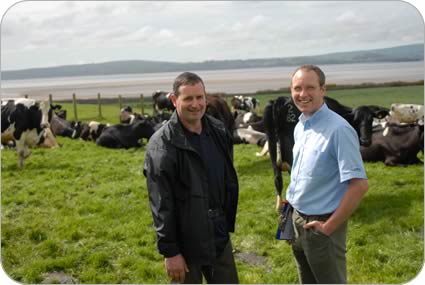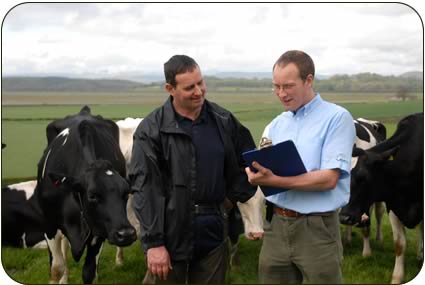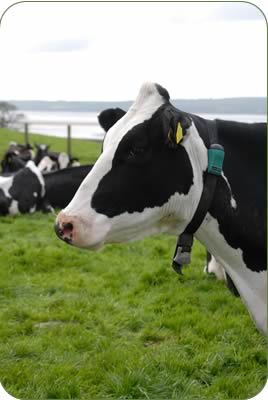Jennifer MacKenzie is an agricultural photo journalist with almost 30 year's experience. Operating from her base in Cumbria, Jennifer undertakes mainly industry-related freelance writing and photography.
Fertility Management
While increasing dairy herd numbers and yields Cumbrian producer Frank
Philipson has maintained already tight fertility management without any
extra labour.
Over the last two years herd numbers have increased from 157 to 180 cows
aiming for 200 by the end of 2009 and yields have risen to 9,000 litres.
Frank and his wife Janet employ two full time men at the 320 acre Canonwinder
farm at Flookburgh on the south coast of Cumbria and with total annual
milk yields running at 1.6 million litres this equates to a production
of more than half a million litres for each man managing the cows.
Keeping on top of the fertility has been as a result of the installation
of ai24 Heatime (Semex) activity meters in June 2008. The Philipsons made
an investment of £3,000 for the system and 70 collars which Frank
says has more than paid for itself.
“We have maintained our calving interval as well as increasing cow
numbers and milk yields for what would be the equivalent cost of two replacement
heifers. We have also saved on semen costs,” said Frank.
“The system is an extra management tool which is recording the cows’ activities
24 hours a day,” he added.
Herd numbers and yields have been built up without buying in any females.
In the last three years heifers, which calve at just over 23 months old,
have been AId with sexed semen and some of these daughters are coming into
the herd this year.
In anticipation of having surplus females to sell, Frank, having used all
pedigree Holstein semen, is registering the herd.
 |
| Frank Philipson, left, and vet Richard Knight |
Selecting for production, type and in particular good udders and feet,
recent AI sires used have been Dolman, Buckeye and Final Cut.
Data gathered with the Philipsons’ vet Richard Knight, of Westmorland
Veterinary Group in Kendal, who makes fortnightly routine visits to Canonwinder,
revealed immediate results following the installation of the system.
The NMR recorded herd’s median calving interval has been maintained
and is running at 368 days with 60 per cent of the breeding herd in calf
and milking.
The average calving interval of 50 randomly selected NMR Holstein herds
with a lactational yield of between 9,000 and 10,000 litres is 430 days.
A group of 58 cows were fitted with the collars and compared with another
group of 69, all of which calved from June 1 to September 17, the herd’s
peak calving period.
“Heat detection rates were significantly better after the installation
of the system – 61 per cent for the cows with collars compared with
22 per cent for the control group,” said Richard, whose practice
a member of XLVets, has been working in a knowledge transfer partnership
with Semex on the system.
Nine of the practice’s 89 clients with dairy herds have been using
the system successfully since it was launched last summer. The Philipsons
have been clients of the Westmorland group for three years taking advantage
of its dairy specialism.
“Calving to first service was 10 days less while calving to conception
interval was the same, so by 63 days calved 20 per cent more calves were
served.
“Positive pregnancy diagnoses during my routine visits were 12 per
cent higher in cows on the system. There also appears to be a small reduction
in the use of prostaglandin injection with more aberrant heats due to ovarian
follicular cysts being detected too,” he added.
 |
| Frank Philipson, left, and vet Richard Knight discuss the Holstein milkers at Canonwinder |
Cows’ activity is monitored 24 hours a day by the electronic neck
collars which are detected by a reader as each animal leaves the parlour
twice a day and the information is analysed by a control box.
The system can be benchmarked against previous herd activity levels to
take into account such periods as turn-out.
Infrared technology gives improved accuracy of data transfer revealing
exactly when a cow should be inseminated.
Richard Knight said into the teens of cows are served on dairy farms when
they are not in heat and conversely when they are already in calf, wasting
semen and risking a pregnancy.
“The system is very easy to use and it is farmer-friendly. Because
it is monitoring the cows through the night, it picks up on cows which
may only be bulling for a couple of hours and then by morning milking showing
no sign. It also gives a precise time of peak activity so that I can time
the AI accurately for 12 to 15 hours later and improve conception rates,” said
Frank.
“It has also picked up cows which are lame and other conditions such
as a twisted stomach. With so many heifers coming into the herd – 40
of the current 166 milkers are heifers and there is a total of 121 heifers
on the farm – it checks their activity as they are the most vulnerable
group at housing,” he added.
Ideally Frank would like all cows other than those which are dry to have
collars. All are fitted within two weeks of calving until they are pregnancy
diagnosed in calf, however the collar was left one cow which was carrying
twins to monitor her progress.
He says the neck collar monitors all activity and, in comparison with a
pedometer, it is easier to fit, particularly on a heifer, and does not
get so dirty.
 |
| A Holstein at Canonwinder wearing a neck collar with transponder |
Milk is sold to Wiseman on a Tesco/Sainsbury contract and while the calving
pattern peaks in August with few calving from January to March, the aim
is to go for a more level pattern, placing even more emphasis on keeping
a tight rein on herd fertility.
Currently the peak serving time is January and a Limousin bull is run with
the herd at turnout in mid-March until June. Heifers are calved in June
to replace cows which are dried off.
The herd has had an average milk price of 28.9p per litre for the 12 months
to March 2009, with a March price of 27.1p.
The diet includes whole crop wheat grown on 30 acres along with silage,
which is taken in three cuts, and pressed pulp fed through a diet feeder.
The milkers are topped up to yield in the parlour with an 18 per cent protein
concentrate.
While the farm is principally dairy, carrying 325 females, 281 of which
are Holsteins, there is also a flock of 200 Mule sheep which lamb in January
and some store cattle.
Although heifers are being brought into the herd to build up numbers, the
average is 2.75 lactations and there are a large number of fifth and sixth
lactation cows as well as some in their seventh.
The oldest cow is almost nine years old, the youngest two years four months
46 days after calving.

